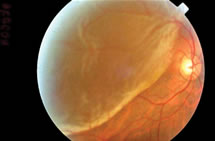Retina Center
Floaters and Flashes
Floaters may appear in your vision as a variety of different shapes. Often they are noticed when looking at plain background, like looking into the sky or at a wall. The vitreous gel develops clumps or strands which make shadows on the retina, then you spot the floaters in your vision.
Flashes appear as flashing lights or lightning streaks. They can appear on and off for multiple weeks, and become more common as the eye ages. Some people experience the flashes of light appearing as jagged lines in both eyes at once, lasting from 10 to 20 minutes. These flashes are usually caused by a spasm of blood vessels in the brain, which is a migraine.
Floaters maybe be caused by a tear in the retina which is a serious problem. If a retinal tear is not treated then the retina may become detached from the back of the eye. The only treatment for a detached retina is surgery. Other floaters are harmless they will disappear over time and will not require any treatment. If you are familiar with floaters because you have suffered from them for years, you should still see your doctor if new ones suddenly develop.
Your eye doctor may dilate your pupil with eye drops to do a full examination. The exam is painless. Your doctor will examine all the areas of your eye including the retina and vitreous gel. If your eyes have been dilated, you will require a ride home after your appointment.
Floaters are more common when people reach middle age. The vitreous gel becomes thicker or shrinks as we age, forming strands or clumps within the eye. The vitreous gel can begin to pull away from the back of the eye, causing a posterior vitreous detachment, a common cause of floaters.
As we grow older, it is more common to experience flashes. They can appear off and on for several weeks or months. If you notice the sudden appearance of light flashes, you should contact your eye doctor immediately in case the retina has been torn.
Retinal Detachment

The symptoms of a retinal detachment may include the sudden development of floaters and flashes. Bleeding from the tear in the retina can cause the floaters, and pulling from the vitreous jelly causes the flashes. If the retina starts to become detached a patient may see a blurry image in the edge of their vision, as progression increases the blurriness may enter the center. If the retina fully detaches, the macula also becomes detached, the vision will become rapidly worse. Patients experiencing these symptoms should see an eye doctor immediately.
There are treatment options for a retinal detachment. If the retina has only experienced small tears than treatment with a laser can usually fix the tear, close monitoring will follow. If the retina becomes fully detached than a silicone band, called a scleral buckle, may be placed behind the eyelids to help the retina become reattached. A vitrectomy, a surgical procedure where the vitreous gel is removed may be needed to help repair the retina. If a retinal detachment involves only the peripheral retina, then surgical repair usually helps maintain excellent vision. If the detachment has progressed to involve the center of vision, the macula, then some vision may be lost, even after surgical reattachment of the retina.

